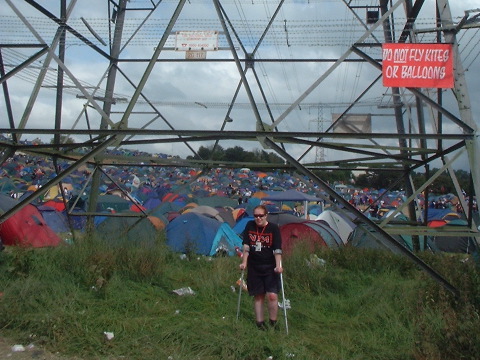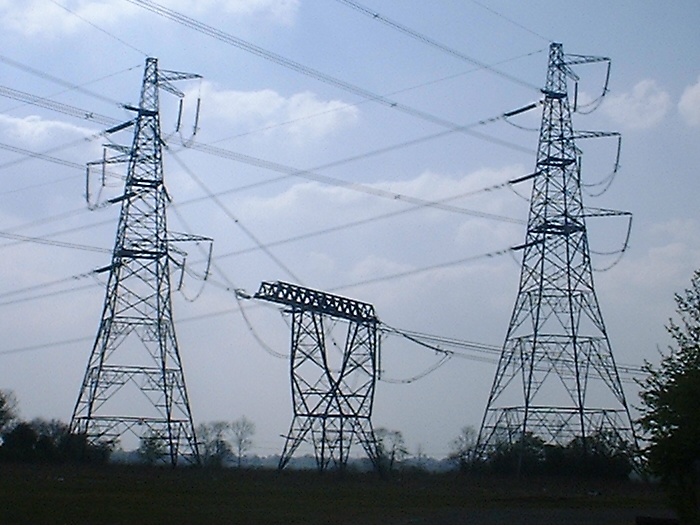
Profile: Flash Wilson Bristow
Why I like pylons, and how my website grew!
I'm not an insulator collector, but rather I have a passing interest in
them - my real enthusiasm is for pylons.
As a child I saw the TV advert for the sale of National Power and PowerGen, in which lattice towers
stride about the landscape, and from then on I took a passing interest in
them, something to make car journeys more interesting and to look at as the
scenery rolled by.
In 1999 I had a job working shifts in the IT industry, and to keep myself awake
on the nightshifts I decided to create a website. One of the sections I decided
to include was "mad things" and this included "things which are black and orange"
right through to "pylons"! At first, I had one page of pylons, with old black and
white photos which I had scanned from a book belonging to my partner's dad. In
fact it turns out that my partner has a father who, although retired, still
sometimes works on overhead line construction projects, most recently in Kenya.
He challenged my interest in pylons as being something trivial and fun and made
me wonder why I liked them, what exactly interested me, and why on earth there
were different shapes.

Flash under a pylon at Glastonbury Festival in 2002.
I began by noticing that pylons come in two different types - suspension
(where the insulators hang down) and tension (where they go out straight
to each side), and then realised that in order to turn a corner or to
terminate a line different designs are used. This fuelled my enthusiasm
and made me wonder more.
I started taking photos of pylons (and a few poles) which interested me, and
it gradually took off from there - people started sending me photos of pylons
they'd seen on holiday, and I approached other people with interesting images
in their online holiday snaps, to see if they'd let me use their images. Now
given the increased use of digital cameras, people can easily take hundreds
of photos and send them immediately by email. This means that my friends,
colleagues, and even people I've never heard of, take photos of pylons they
see on their travels and send them to me! At the time of writing, my website
has 385 photos from 34 countries - mostly of "interesting" pylons (or those
in unusual locations such as spanning a canal) rather than the standard designs.
Of course it's not just about numbers and having the most pictures I possibly
can, although I'd love to have photos of pylons in every country. (This may
be impossible; I imagine there might not be pylons or poles in Antarctic
territory for example.) As I've looked more at pylons I've come to wonder
more about them - although it's still from an amateur point of view, I do
seek to be better informed, so all comments and assistance are welcomed!
I enjoy speaking with my partner's father about pylons, and reading his old
books (some from the sixties which are now out of print, such as "Overhead
Line Practise" by McCombe and Haigh), and he patiently answers my questions.
I often get emails through my website such as "who owns this pylon?" or
"can I get cancer from a pylon" and I've developed the site to include an
FAQ to deal with this; it also meant that I've had to expand my knowledge
in order to be able to respond to people.
I've learnt things that now seem obvious but which I didn't know, for example
that the reason pylons hold wires in multiples of three is so there is one
wire for each phase on a line - which means that the electromagnetic field
experienced on the ground under wires at any time should be nil. I've also
read about transposition towers, where the electricity on one wire is swapped
onto another and so forth, so that on average the capacitance of each wire
travelled by the three phases is the same, and so there are no problems when
the line is presented to equipment at the end of it. (At least that's how I understand
it!)
I've also been interviewed for Jack Magazine, which posed yet more questions
and made me think again, for example about my favourite pylons and those
which are the "top dog" of the UK. For the curious, my favourite pylons
are some just outside the village of Cressing in Essex. They are an unusual
design and stand in a field routing wires from one circuit under those
of another into a substation. They are shown below.

Pylons in Cressing village, Essex
I think the title of "top dog" should go to the pair which span the Thames
at Thurrock - at 630ft they are higher than the Post Office tower! I recently
received an email from a contractor who has climbed them and I'm looking
forward to hearing his war stories.
I've also made model pylons - you can buy a kit for Hornby's 00 Gauge
trainset comprising three pylons based on those near their factory.
They are readily available for just over £10 per set, and proudly
strut along the top of the radiator in my study! However, the most
fun you can have with a pylon (in my opinion) is to take a fluorescent
tube and stand under the wires, somewhere where there are lots of different
circuits converging such as near a substation. The tube glows - it's a
spooky feeling - and along with the corona discharge crackling and
static electricity, it's quite unnerving. I'd have to check my physics,
but I'm told the reason it works is as a result of the electric field
produced between the different circuits; if I stood under a single line
it would have no effect.
One of the difficulties I've had is that many transmission companies
are unwilling to answer my questions; it's like getting blood out
of a stone. Usually the requests go ignored. It's a shame; I'd love to learn
more. I know that much of what I've picked up is also from enthusiastic
amateurs and I'd love to be better informed. At present I rely on other
enthusiasts to educate (or correct) me.
My future plans include learning more about pylons, their design and
purpose; visiting the Museum of Electricity in Christchurch, Dorset;
and of course to collect images of pylons in more countries!
Finally, I couldn't write my story without mourning the loss of possibly
the most famous pylon in the UK; the "pink pylon" which was featured in
the film Among Giants as the pylon which was painted by a gang of workers.
The line was decommissioned and the pink pylon dismantled in November 2003.
What a shame! Still, the fact that this pylon had its own website (run
by John Scott) and the number of emails I receive tells me that I'm not
alone... pylon fans are on the increase!
My website can be seen at http://www.gorge.org/pylons
All images are copyright of their respective owners and may not be reproduced elsewhere in any way
This page last updated: 01 September 2022

If you have a comment, please leave it in the guestbook. To contact Flash directly, complete this form. Like this site? Buy me a drink!
This site moved from a fixed width to the current layout in 2009. Some older content such as photo sets may still have a fixed width. However if you notice any pages which are actually broken, please be kind enough to let me know via this form.
© Flash Wilson 1999-2010. I charge a fee for use of my photos.
